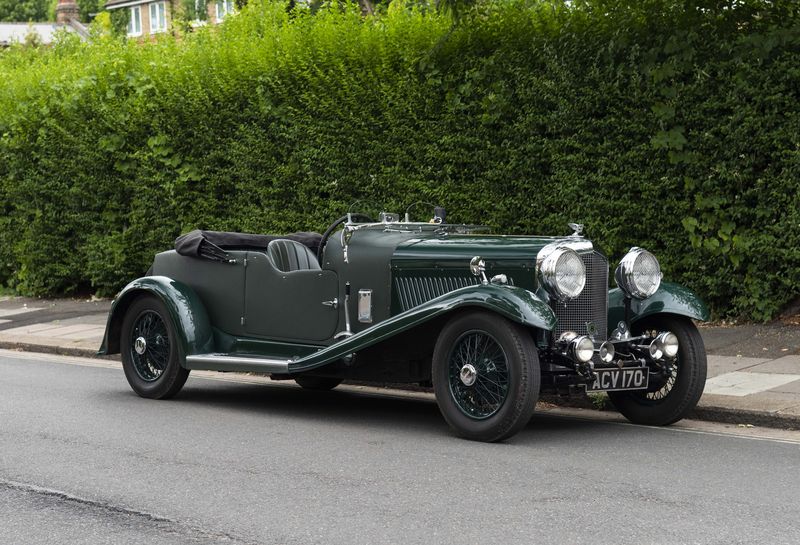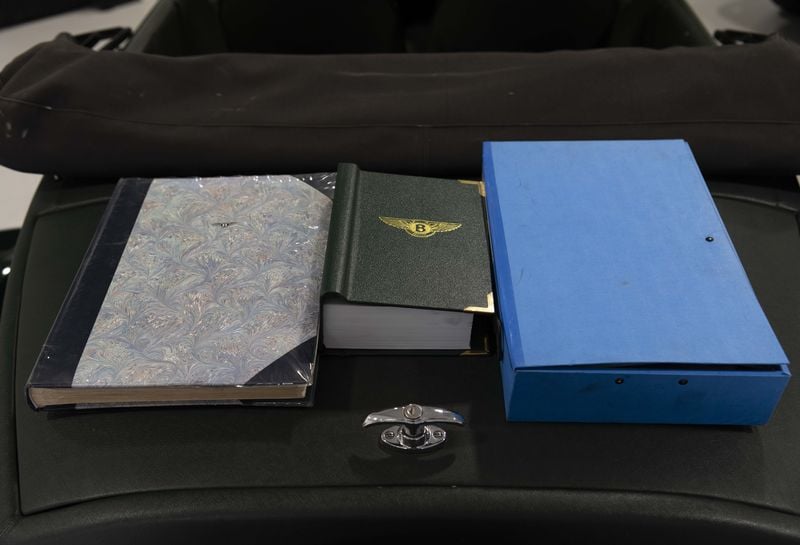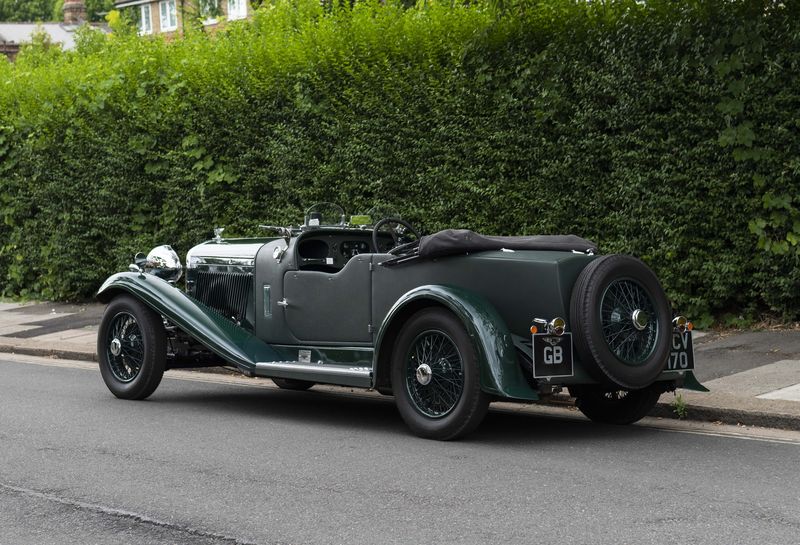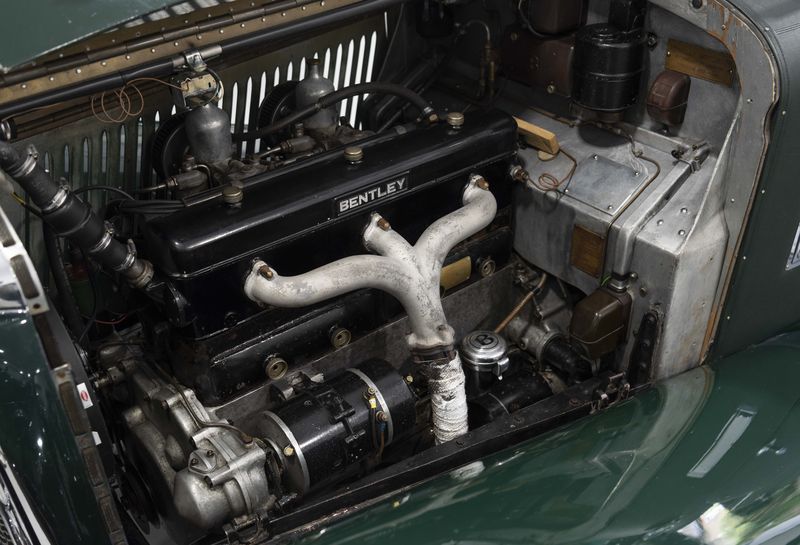Highlights
- Comprehensive engine and gearbox overhaul in 1997
- Sporty Vanden Plas-inspired body
- Enormous collection of invoices
- Photographic record of work carried out
- Beautiful condition throughout
The Appeal
W. O. Bentley unveiled his first car at the 1919 London Motor Show and, after just a few years, the Bentley name was world-famous thanks to the Three-Litre’s success in long-distance races. John Duff and Frank Clement’s car finished joint fourth in the first 24 Hours of Le Mans in 1923, and they returned in 1924 to take outright victory. Bentley went on to win four consecutive victories from 1927 to 1930 with its Three-Litre, 4½-Litre and Speed Six.
By now universally recognized as one of the world’s finest builders of large, high-quality sports-cars, Bentley had also attempted, less successfully, to step into the luxury market in 1926 with the short-lived 6½-Litre. Sadly, it could not manage its finances with the same skill with which it built motor-cars, and the company folded in 1931 with its swansong being another luxury model, the magnificently opulent and prodigiously powerful Eight-Litre.
With the Bentley name and assets available to the highest bidder, they were bought in 1933 by Rolls-Royce, ensuring that the revived marque would complement Rolls-Royce’s own cars rather than rivalling them.
Built at the Rolls-Royce factory in Derby, and hence known as Derby Bentleys, Rolls-Royce acknowledged Bentley’s sporting pedigree by equipping its new model, the 3½-Litre, with a tuned version of the engine used in the Rolls-Royce 20/25.
Built at the Rolls-Royce factory in Derby, and hence known as Derby Bentleys, Rolls-Royce acknowledged Bentley’s sporting pedigree by equipping its new model, the 3½-Litre, with a tuned version of the engine used in the Rolls-Royce 20/25.
Although Bentley would never build another true sports-car like it had made in its Le Mans days, the 3½-Litre was still irrepressibly lively, as Rolls-Royce had increased its compression ratio, modified its camshaft and given it twin SU carburettors.
The resulting 110bhp engine made for a car which would hit 90mph, depending on coachwork. Rolls-Royce had judged the market very well, as the Bentley appealed to a more youthful clientele, who expected Rolls-Royce quality and luxury but equally desired to slip behind the wheel themselves and enjoy some spirited motoring
The resulting 110bhp engine made for a car which would hit 90mph, depending on coachwork. Rolls-Royce had judged the market very well, as the Bentley appealed to a more youthful clientele, who expected Rolls-Royce quality and luxury but equally desired to slip behind the wheel themselves and enjoy some spirited motoring
‘Spirited motoring’ is precisely what this Bentley is for, with its low-cut and lightweight tourer body inspired by the Vanden Plas coachwork famously worn by the Le Mans Bentleys of the late 1920s. Having unfortunately lost its original Barker body, chassis B103BL was brought back to life from a bare chassis over a period of six years.
The result looks every bit like the archetypal pre-war British sports-car, and for high-speed, long-distance drives—perhaps even an endurance rally—there can be nothing better.
The result looks every bit like the archetypal pre-war British sports-car, and for high-speed, long-distance drives—perhaps even an endurance rally—there can be nothing better.
The History and Paperwork
- Chassis B103BL was originally bodied by Barker and first owned by Evelyn Boscawen, 8th Viscount Falmouth, in London
- Recipient of a comprehensive engine and gearbox overhaul in 1997
- By 2004, the Bentley had lost its Barker body and was purchased by an enthusiast as a rolling chassis
- The then-owner committed to bringing it back to life, commissioning Randall Stewart to construct a tourer body after the Vanden Plas bodies fitted to the late 1920s Le Mans Bentleys, but using a more modern method of constructing a frame from square steel tubing, which would then be clad along traditional lines in aluminium with a fabric covering
- The build took place over six years, from 2004 to 2010
- Paperwork includes the current V5, copies of the original Rolls-Royce factory build sheets, a FIVA registration certificate from 2012, an enormous assortment of invoices and a photograph album documenting the build from beginning to end
- A copy of The Derby Bentley Technical Manual, published by the Bentley Drivers’ Club, is supplied in very good condition
The Interior
- Beautifully trimmed in dark green leather
- Full of authentic, period details, like the string-wrapped steering wheel
- Usefully equipped with a large boot area
It’s not just in the bodywork that this 3½-Litre takes influence from the Le Mans Bentleys. One of the nice detail touches is the steering wheel which is wrapped with string for better grip, as was common practice on pre-war racing cars.
The dash itself is suitably purposeful, having obviously been built specially for the car. The plain finish is smart and presentable, and recalls the simple and uncluttered fascia of the Three Litre. It’s all in excellent condition, of course, and doesn’t appear to have aged since it was constructed over 12 years ago.
The dash itself is suitably purposeful, having obviously been built specially for the car. The plain finish is smart and presentable, and recalls the simple and uncluttered fascia of the Three Litre. It’s all in excellent condition, of course, and doesn’t appear to have aged since it was constructed over 12 years ago.
The upholstery is equally superb. Of course, since the Bentley has only covered 6,000 miles since its reconstruction, the seats have barely ever been sat on. A very nice, supple leather was used for the task, and they have been finished in just the right shade of green. The carpets, too, are extremely clean and more or less still like new.
Because the 3½-Litre has a wheelbase some 10 inches longer than the 4½-Litre, not only is there plenty of room in this car for the back-seat passengers, but space has also been made at the rear for a boot, which is a luxury most Vintage Bentley owners did not have. Although the boot is not enormous, it’s got plenty of space for a few shopping bags or luggage for a weekend break, which makes B103BL seem decidedly practical.
The Exterior
- Body constructed between 2004 and 2010 from square steel tubing and aluminium panels
- Fabric-covered in the fashion of the Le Mans Bentleys and many other sports-cars of the 1920s
- Superb condition all-round
Built, as the original Cricklewood and Derby Bentleys were, by a craftsman, chassis B103BL looks phenomenal. The inspiration for the bodywork was the Vanden Plas bodies of the Vintage period, and the right details are there: the waistline lower than the scuttle and the cut-out sections in the doors are hallmarks of Vanden Plas bodywork. The Brooklands aero screens are another appropriate, racing-inspired touch.
We may call the paint British Racing Green but, of course, that does not really denote any specific shade, so perhaps a more accurate name for the colour would be Bentley Le Mans Green, for there is surely no car which has ever worn it so famously and so effortlessly as the Vintage racing Bentleys. Since the 3½-Litre has only seen limited use since its rebuild, it’s not surprising that the paint is still essentially immaculate.
From the scuttle back, the bodywork is fabric-covered. The material used is a kind of vinyl, although in period it would have been Rexine. However, there is only one company in the world capable of remanufacturing Rexine and it comes at quite a price, so many restorers prefer a vinyl substitute, since you’d be hard-pressed to spot the difference. Either way, it works to very good effect on this Bentley, and again all is virtually pristine. While the use of steel tubing is not traditional, it does ensure a much stronger construction than a more period-correct ash frame.
The wheels are in very good condition, since they were respoked using the original rims and hubs. The folding hood should provide ample weather protection, and we believe that to be in excellent order, too.
All the brightwork is splendid, and the great chrome radiator, flanked by two proud Lucas headlamps, announces the Bentley’s arrival with a fitting sense of authority and dignity. There is a very light patination beginning to appear on some parts but, unfortunately, the chrome on the horns seems to have deteriorated. While this is by no means the end of the world, for show purposes you might wish to have them replated. If it were down to us, though, we’d be wanting to drive the Bentley and we certainly wouldn’t enjoy it any less.
The Mechanics
- Beautiful six-cylinder engine in a tidily-presented engine bay
- Several subtle modern upgrades
- Capable of 90mph in period
They say you shouldn’t judge a book by its cover, but we think it should be safe to judge this Bentley’s mechanicals by the standard of its bodywork, not to mention the mountain of invoices detailing the extensive, meticulous and thorough work which it received while it was being rebuilt.
Although the rebuild took place between 2004 and 2010, the Bentley must have been operational in some capacity during that time as it was MoTed every year from 2006 to 2011, passing every time with no advisories. At the time of its test in April 2006, it had covered only 7,304 miles since its engine rebuild, and by October 2011 that number had risen to only 7,988. Although its last MoT expired in 2012, it has evidently seen some recent use as the odometer now reads 13,814 miles.
We know that the engine and gearbox were rebuilt in 1997 in the well-known workshops of Fiennes Engineering, but since then just about everything else has received attention of some kind, with invoices on file for a full brake overhaul, among many other things.
It may be seen that the Bentley has received a number of subtle upgrades to make it more usable in the modern world, including twin electric fuel pumps in the boot and small K&N air filters on each SU carburettor, as opposed to the large and bulky air filter which originally sat above the rocker cover.
It may be seen that the Bentley has received a number of subtle upgrades to make it more usable in the modern world, including twin electric fuel pumps in the boot and small K&N air filters on each SU carburettor, as opposed to the large and bulky air filter which originally sat above the rocker cover.
The Bentley starts and runs very nicely and we are advised that the original one-shot lubrication system remains in full working order.
The Summary
Following its takeover by Rolls-Royce, the Bentley marque stood for luxury but with an extra sporting dash. We can see that in this handsome Vanden Plas-inspired special, with an emphasis on the ‘sporting’.
Like many pre-war Bentleys, it comes with an interesting and aristocratic early ownership history but, also like many pre-war Bentleys, its chassis has outlived its original coachwork.
With this having been bought as a rolling chassis in 2004, its restorer did an excellent job of breathing life back into it, and the result is a characterful and good-looking tribute to Bentley’s 1920s Le Mans victories, with a few discreet improvements for modern-day use, from a bit of boot space to subtle mechanical upgrades.
With this having been bought as a rolling chassis in 2004, its restorer did an excellent job of breathing life back into it, and the result is a characterful and good-looking tribute to Bentley’s 1920s Le Mans victories, with a few discreet improvements for modern-day use, from a bit of boot space to subtle mechanical upgrades.
To the best of our knowledge, this car qualifies for Vintage Sports-Car Club eligibility, but it will, of course, be more than welcome in Bentley Drivers’ Club events and looks to be especially suited to endurance rallies. There are so many ways to enjoy this car, you won’t know where to begin.
Notice to bidders
Although every care is taken to ensure this listing is as factual and transparent as possible, all details within the listing are subject to the information provided to us by the seller. Car & Classic does not take responsibility for any information missing from the listing. Please ensure you are satisfied with the vehicle description and all information provided before placing a bid.
All bids are legally binding once placed. Any winning bidder who withdraws from a sale, is subject to our bidders fee charge. Please see our FAQs and T&C's for further information. Viewings of vehicles are encouraged, but entirely at the seller’s discretion.








